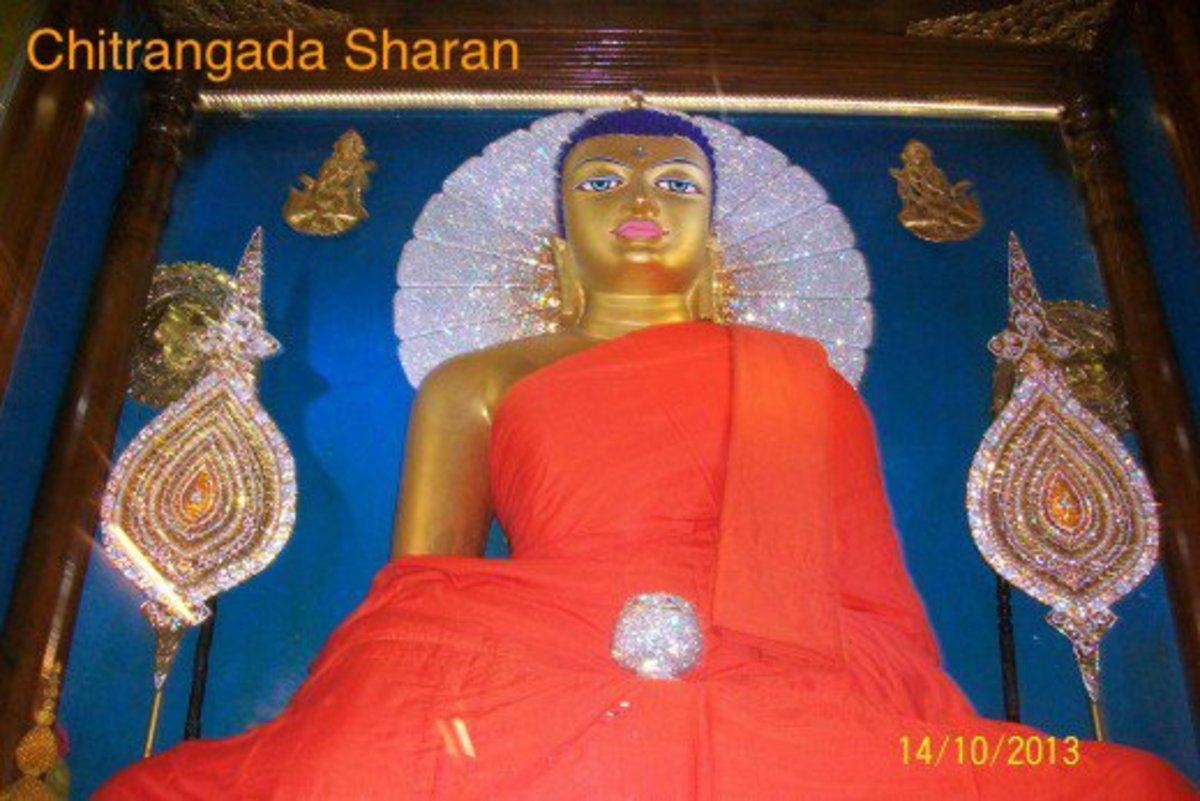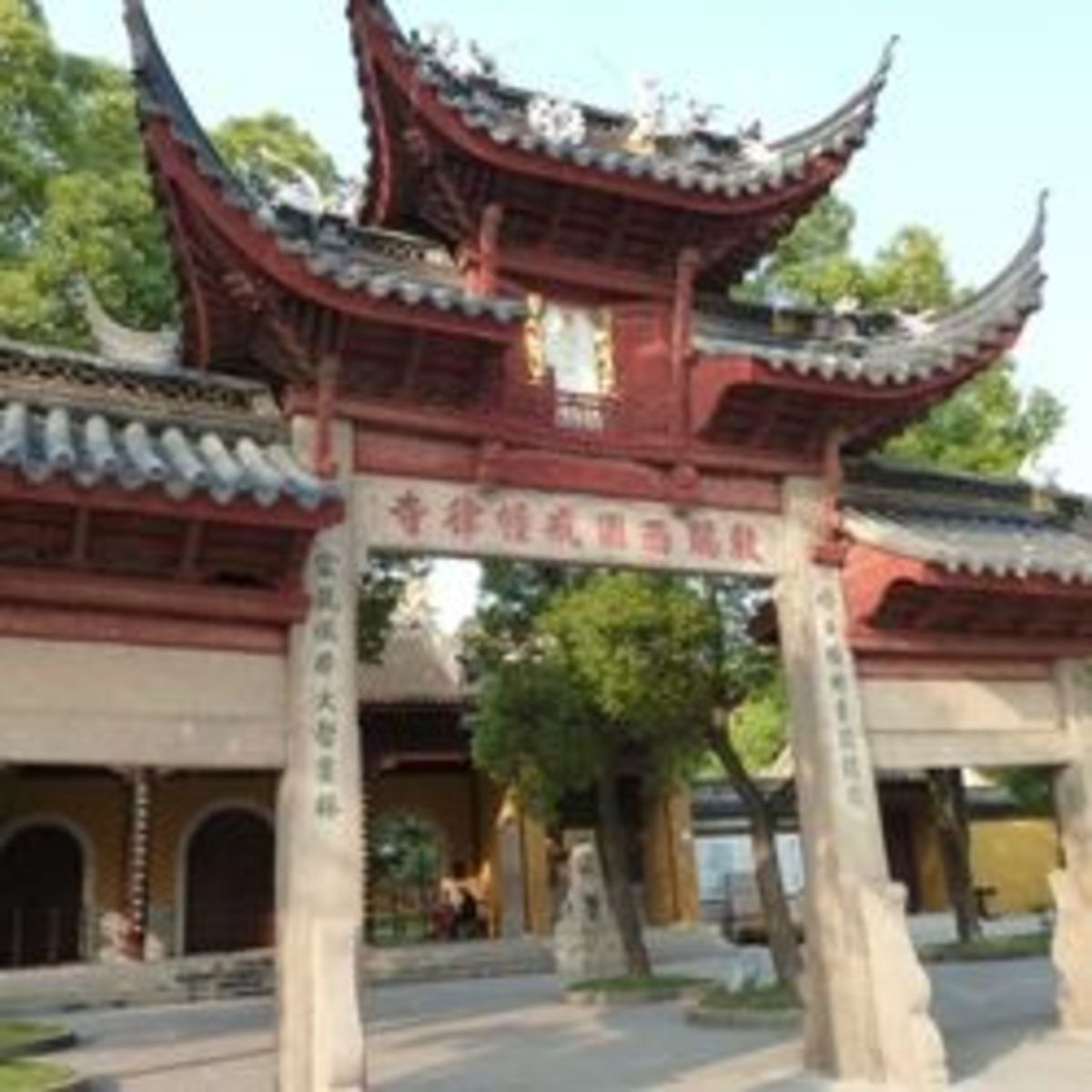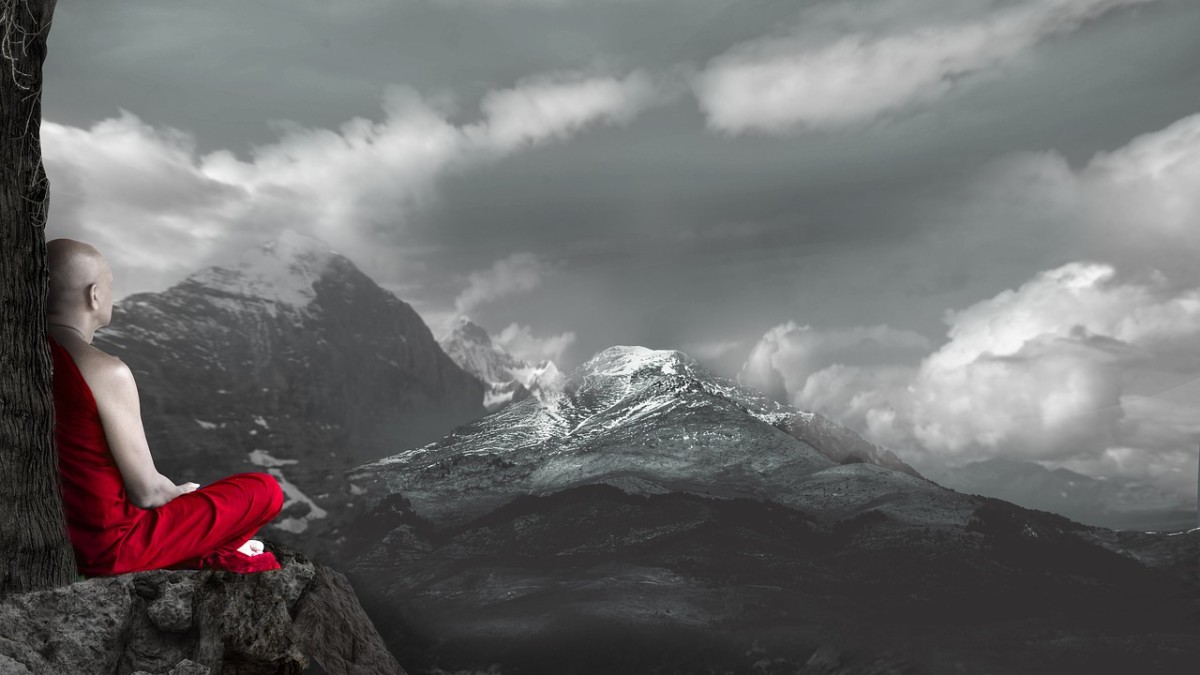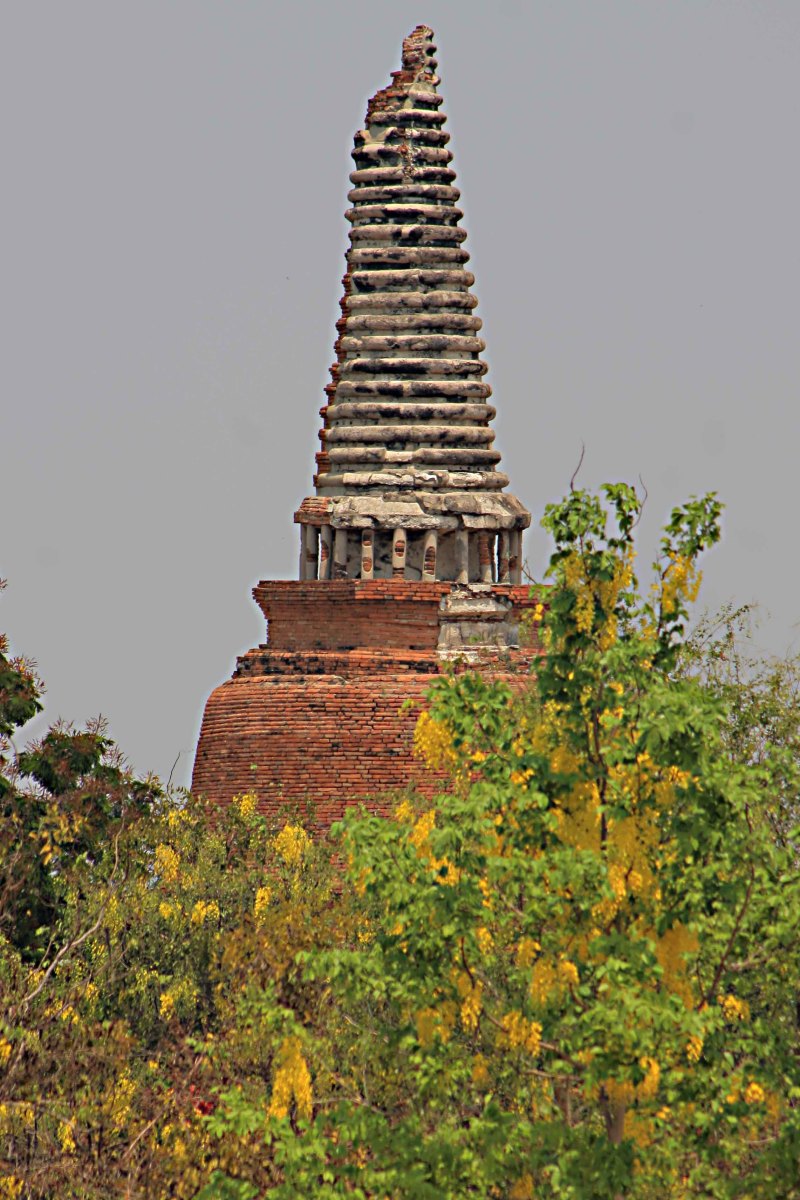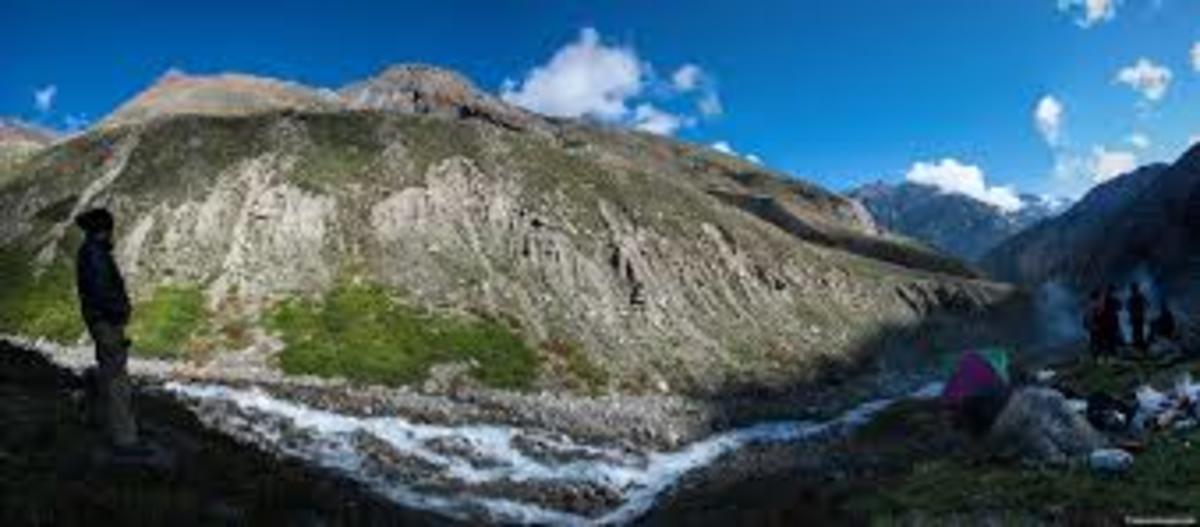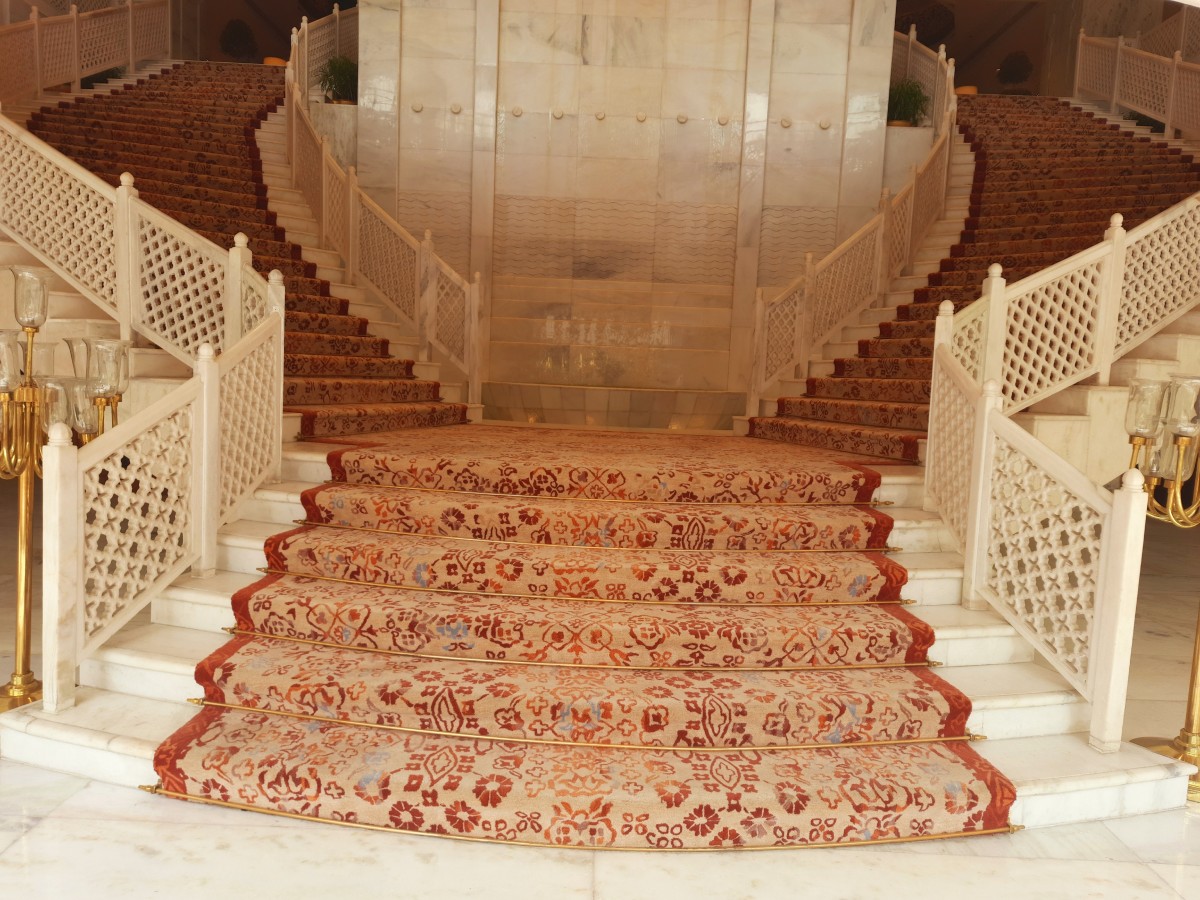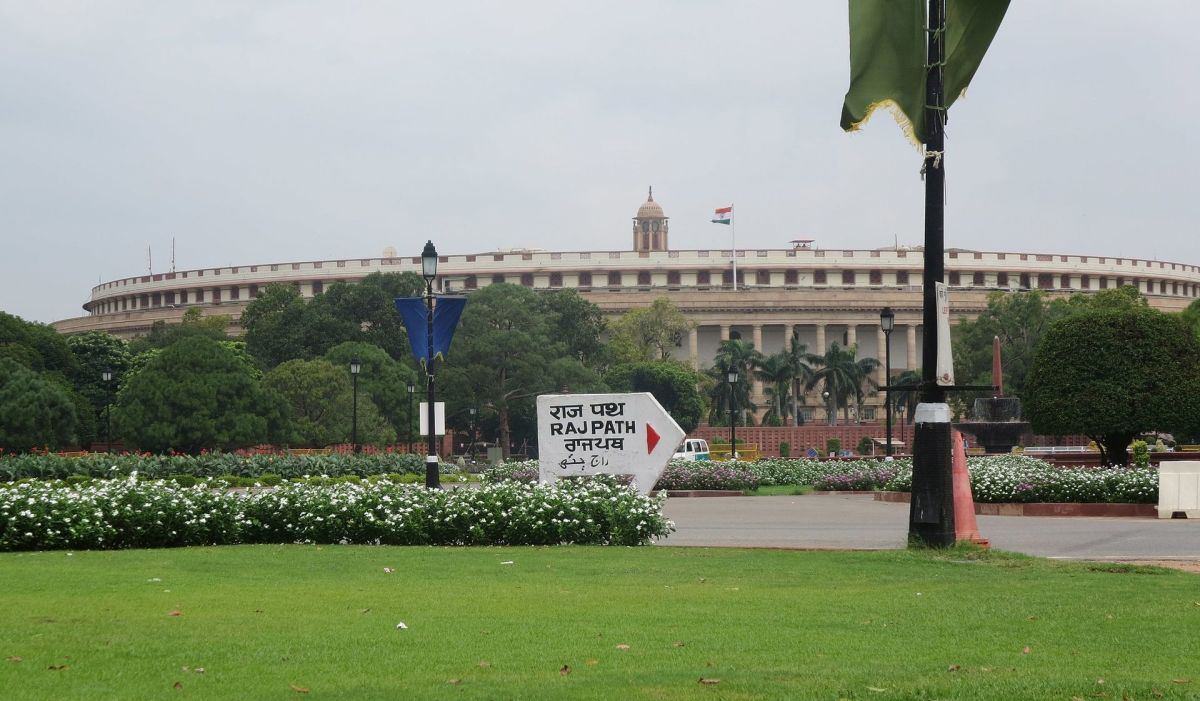- HubPages»
- Travel and Places»
- Visiting Asia»
- Southern Asia
Bodh Gaya- The Least You Should Know Before You Visit
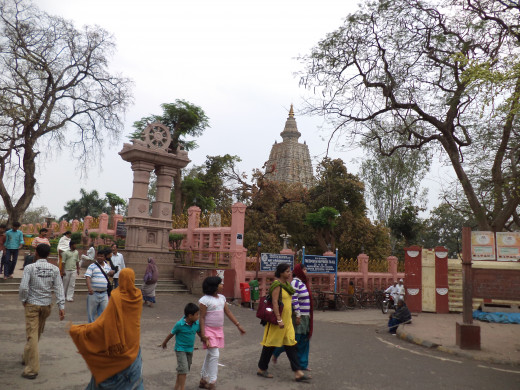
Getting Leaves From The Bodhi Tree
Having been told that leaves from the Bodhi Tree at the Mahabodhi Temple were considered lucky, I sat beneath the great tree for a long time and I prayed and waited for the occasional breeze to dislodge some of the leaves. No luck. Then a group of monks in maroon robes started scanning the ground for leaves and I joined them. They knew where to look.
Soon I found a leaf which was not intact. Then the wind blew and the monks scrambled for the leaves that dropped from the tree. I don’t think more than a couple of leaves floated down. Suddenly there was a gentle tap on my shoulder and there was a beautiful leaf – green, yellow and brown and a friendly young monk offering it to me with a smile!
I thanked him with a ‘namaste’ and accepted it with a big grin. A few moments later an older monk offered me a leaf and so did a pilgrim from Sri Lanka. I thanked them the same way. So selfless! I found two intact leaves myself afterwards.
Later I saw the young monk sitting with his fellow monks near a young tree which was fenced in and a sign on the fence said that The Buddha had rested there after his nirvana. I was amazed at the utter peace and a silence beyond words there, despite the area being crowded with pilgrims from various countries and lectures being held beneath it and monks praying and meditating and a constant stream of devotees around the sacred enclosure that housed the Bodhi Tree and the holy Diamond Throne which marked the exact spot of The Buddha’s enlightenment,
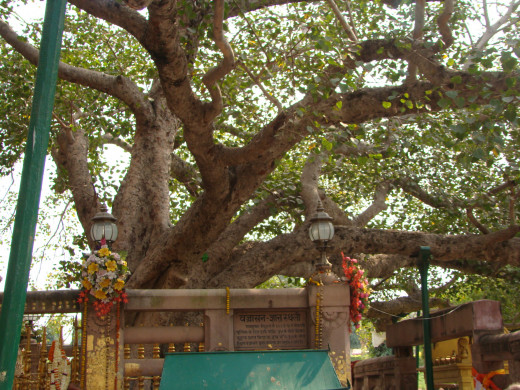
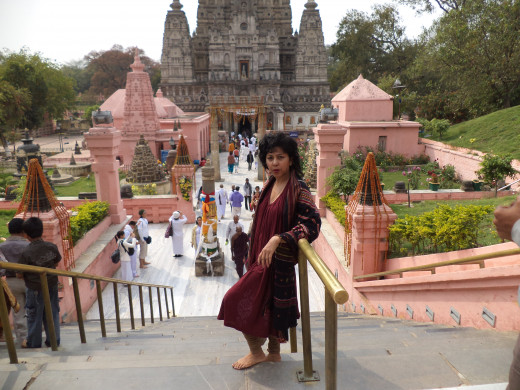
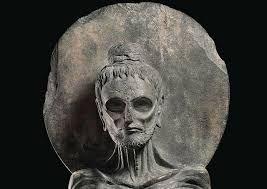
Bodh Gaya – The Place Of The Buddha’s Enlightenment
The Mahabodhi Temple at Bodh Gaya is the most revered in India because it marks the site of Prince Gautama Siddhartha’s enlightenment or nirvana.
Here it was in Uruvela (Gaya today), some 50 miles from the erstwhile capital of the Mauryan Empire –Patna (known as Pataliputra then) that the prince, having wandered to this region after many years of self-denial and self-mortification decided that asceticism was not the way to enlightenment.
After bathing in the river and accepting gratefully some rice porridge from the young girl Sujata, daughter of a rich householder , Siddhartha Gautama sat down under a huge pipal tree, telling himself that he would not rise until he attained enlightenment.
While the universe and the gods rejoiced at his determination and a brilliant light suffused the world, the demon Mara, bringer of death and lord of the five desires along with his daughters – Tanha, Raga and Arati – fumed.
When Siddhartha had been starving, surviving on just one grain of rice a day, Mara had attempted to tempt him away from his great goal, but he had been sent away.
Now as Siddhartha sat beneath the tree. Mara unleashed a whirlwind at Him and a rain of arrows which turned into flowers due to the equanimity and power of the prince who remained unmoved by the enticement of his daughters.
Seeing that he could not arouse desire in Siddhartha, Mara retreated with his evil host of demons.
Then Siddhartha gave himself up to meditation and seeing the root of evil, he thought that if sentient beings could see the results of their evil deeds, they would give them up in shame and disgust. But they were bound by their ego and enslaved by desires. And in the following births they retained their ego and desires which trapped them into rebirth. Their delusion led to anxiety, troubles and misery and they could not escape their self-made hell.
Thus it was delusion or ignorance which was the root of all evil.
The five senses made them cling to things and thus rose ego and the sense of self or individuality.
Siddhartha saw that the destruction of the ego, the selfishness that comes from individuation, led to freedom from birth, old age, disease and death and therefore the end of suffering.
In the course of the night, he went through the eight stages of knowledge, including recalling all his previous lives and then into the transcendent stage of Bodhi or wisdom.
And Prince Siddhartha Gautama, now The Buddha or Enlightened One said:
“Through many births I sought in vain
The Builder of this House of Pain.
Now Builder, thee I plainly see!
This is the last abode for me.
Thy gable, yoke and rafters broke,
My heart has peace. All lust will cease.”
What is this ego, this sense of self which separates us from others? It is the yearning for pleasure and the lust for recognition. Yet the self is an illusion created by craving and all evil, all vice stems from it.
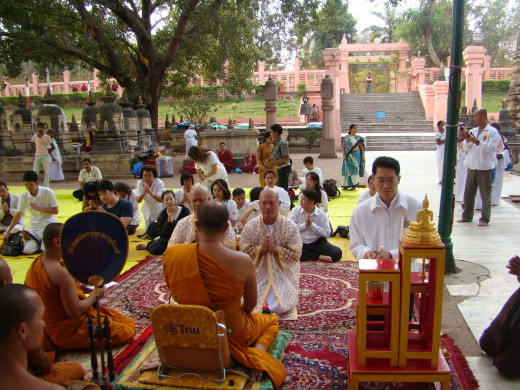
Monk Ordination Beneath the Bodhi Tree
Two middle-aged monks who looked like twins were being ordained beneath the branches of the Tree which extend far beyond the enclosure.
As they knelt before their master, their family members watched them with pride. They were probably from Thailand for earlier in the Thai Monastery, I had seen them too in a gathering kneeling before the Masterwhile their family members bore in their hands the brown robes which were now being offered to them by the master.
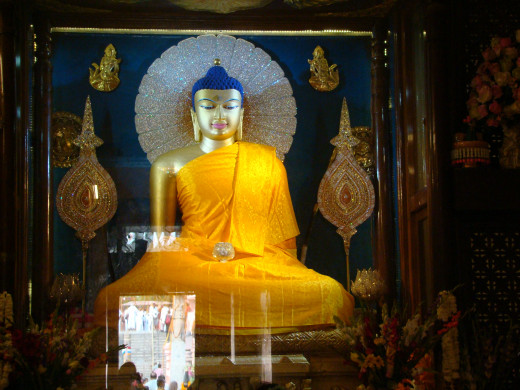
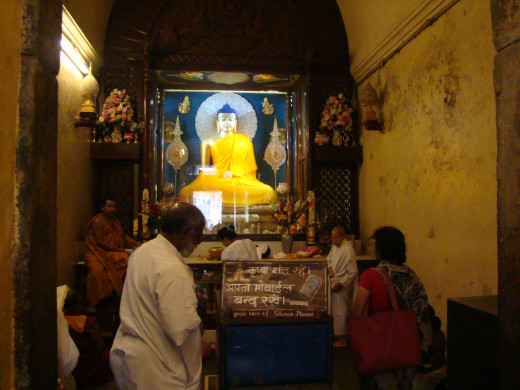
Legend of the Mahabodhi Statue
People say that it takes you two to three hours to get inside the temple to see the beautiful golden statue of The Buddha, with the brilliant halo around His head which looks like it is encrusted with diamonds but I was lucky. He sits right behind the Diamond Throne outside – the western wall of the Temple separating them, facing east, just as he would have during his meditation.
The statue has quite a history. It was found somewhere in the compound and is said to be in the likeness of The Buddha. According to legend, it was created by Lord Maitreya, the future Buddha who was The Buddha’s disciple ,Ajita in a previous incarnation, I have dedicated myself to The Maitreya Buddha for 16 years now.
The legend says that the right sculptor to create the statue of The Buddha could not be found but suddenly a man turned up saying he could sculpt the image. He asked that scented clay and a lamp be placed within the sanctum which had to be locked for six months. But out of impatience and curiosity, the people opened the sanctum four days ahead of time and saw a splendid image of The Buddha with a portion on the breast left incomplete. Some days later, a monk who slept in the sanctum dreamed that Lord Maitreya had sculpted the statue.
Notice that he Buddha’s right hand touches the Earth, asking it to bear witness to His enlightenment.
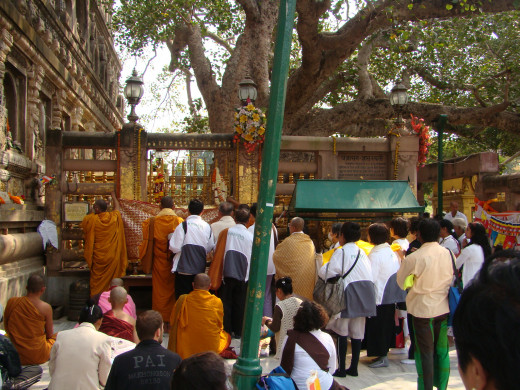
Bodh Gaya - The “Navel of the Earth”
It is believed that no other place besides the hallowed spot beneath the Bodhi Tree could support the weight of The Buddha’s enlightenment. Here the ground remained unmoved while the rest of the Earth shook in a violent earthquake that scattered even Mara and his demon army. This is why this place is known as ‘the navel of the Earth.’ It is also said that this is the spot which will be the last to be destroyed and the first to form again in the next universal cycle.
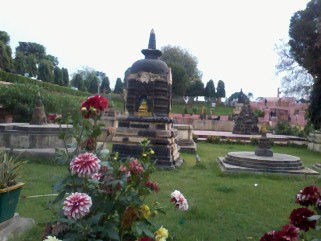
Stupas in the Precincts of Mahabodhi Temple
Outside in the temple precincts are several small stupas commemorating the events that took place in the life of The Buddha here. Monks sit among them with their beads, waiting for leaves from the Tree. Many of these structures were built by Emperor Asoka. And there’s the promenade or ‘Jewelled Walk’ that circles the Temple along which The Buddha paced in meditation after his nirvana. Pilgrims are always on that walk.
The following sites around the Mahabodhi Temple are sacred to Buddhists who visit each one of them:
Week One After The Buddha's Nirvana
When dawn broke, the Enlightened One continued to sit beneath the Bodhi Tree, lost in the bliss of emancipation for 7 days.
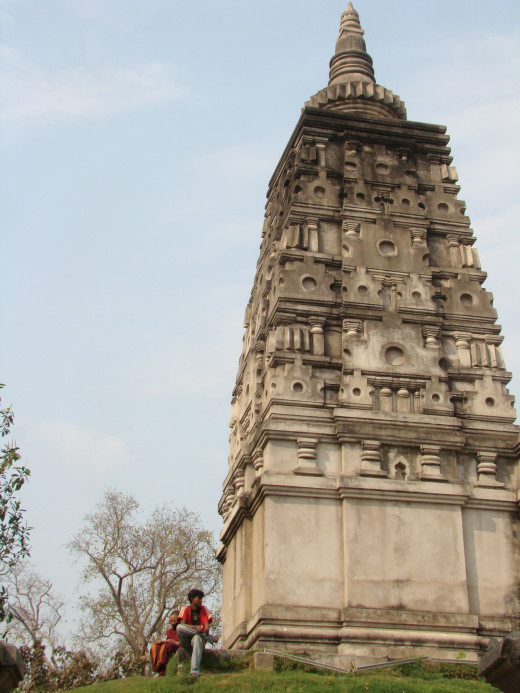
Week Two -The Buddha Thanks the Bodhi Tree
For the next 7 days, The Buddha stood and gazed unblinking in gratitude at the Bodhi Tree. Emperor Ashoka built an elevated shrine over this spot. It is called the Animisilocana Cetiya and it stands in front of the Mahabodhi Temple.
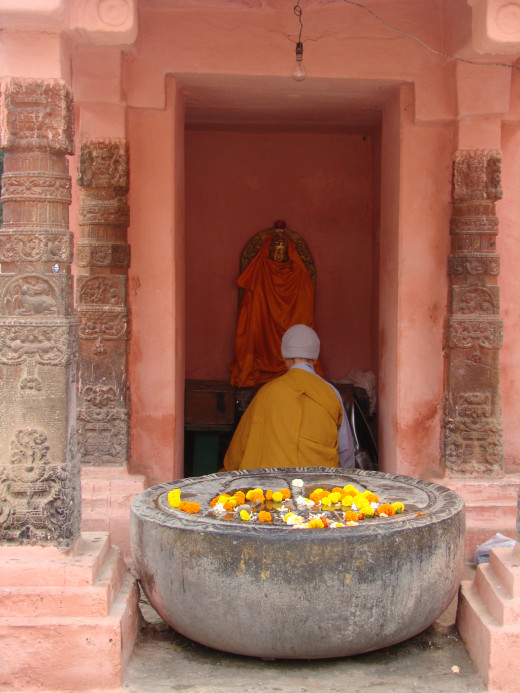
Week Three - The Buddha Walks Along the Jewelled Promenade
For all of the following week, The Buddha walked in meditation along the “jewelled promenade” which runs between the Diamond Throne and the Ashoka shrine.
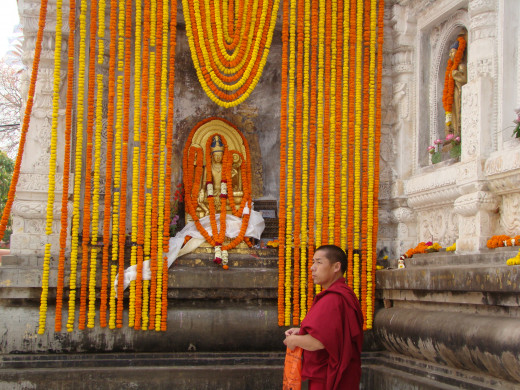
Week Four - The Buddha Emits Light
In the fourth week after enlightenment, The Buddha’s contemplation
Of the doctrine of Conditional Relations caused his body to emit rays of blue, gold, white red and pink. A small shrine to the north of the Jewelled Walk’ marks this event.
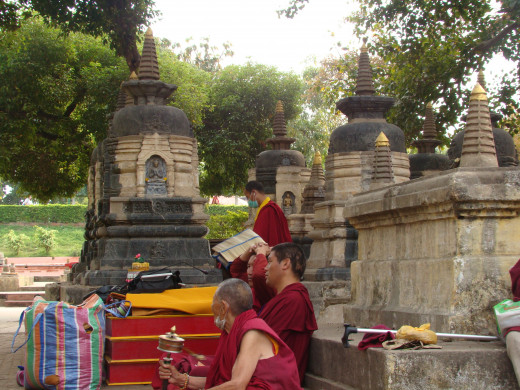
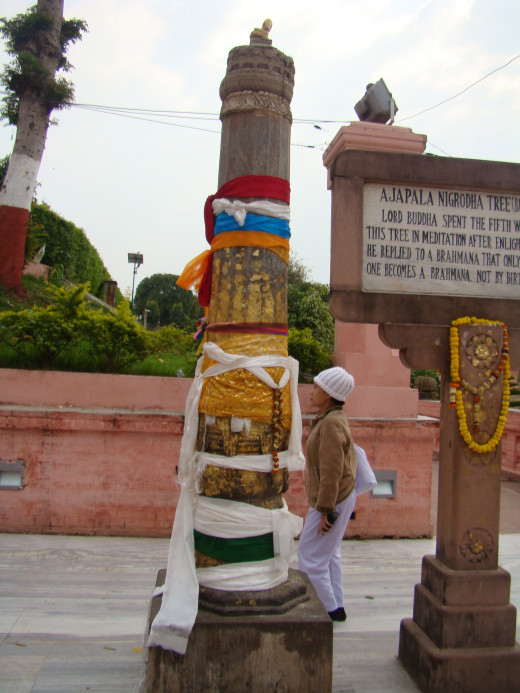
Week Five – The Buddha Explains the Qualities of the True Brahman
The Buddha spent the next 7 days beneath the Ajapala Nigodha Tree in meditation and here he explained to an egotistic Brahman the qualities of a true Brahman. A signboard in front of the Mahabodhi Temple marks this place.
Week Six – The Buddha is Protected by The Serpent King Mucalinda
The Buddha spent the sixth week under the Mucalinda Tree to the south of the temple. A heavy rainstorm arose suddenly during this time and The Buddha was shielded by the gigantic great hooded serpent king Mucalinda that lived in the nearby Mucalinda Lake. The lake is now a pond and you can still see it.
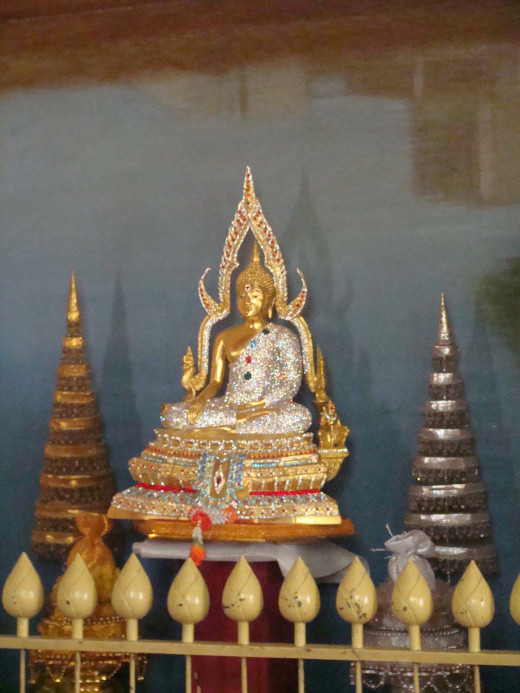
Week Seven – The Buddha’s First Lay Disciples
In this final week that The Buddha spent in the environs of the Bodhi Tree, he meditated for another seven days beneath the Rajayatana Tree near the temple. Here it was that two merchant brothers from Myanmar – Tapussa and Bhallika became his first lay disciples and he gave them some of his hair as relics. A signboard to the south of the temple commemorates this event.
So if you plan to visit the Mahabodhi Temple, you know what to look for.
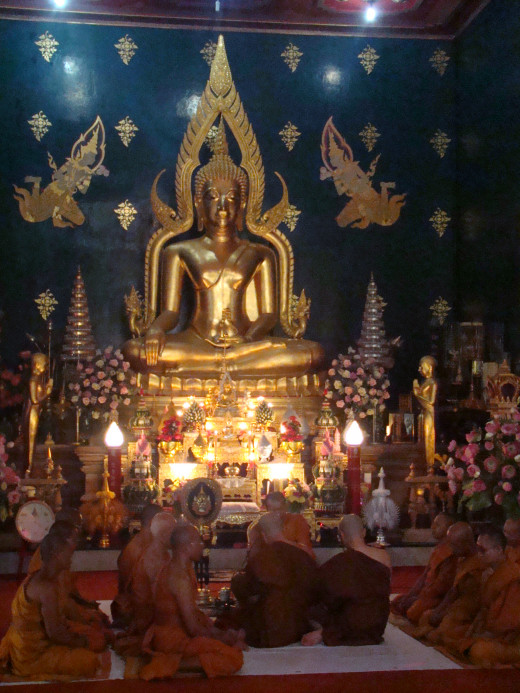
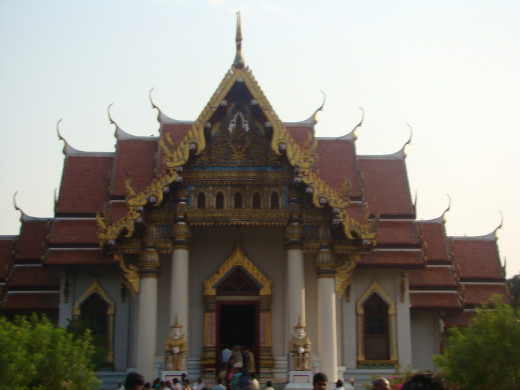
Beautiful Thai Temple in Bodh Gaya
It’s gorgeous with its walls frescoed with scenes from The Buddha’s life and painted window shutters. Outside at the gate a monk sells beautiful ‘singing bowls’ made of 7 metals and so the lovely layered sound. It is used in meditation and also for healing. It is believed to clear negative energy from the home. I bought a couple of these. I think the Thai temple/monastery is probably the most beautiful of the many in Bodh Gaya.
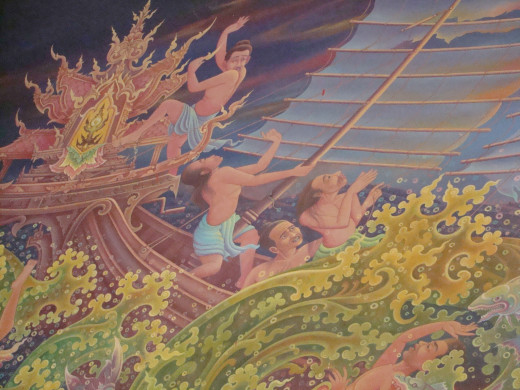
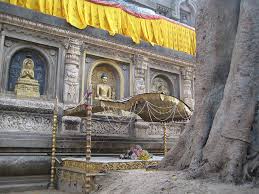
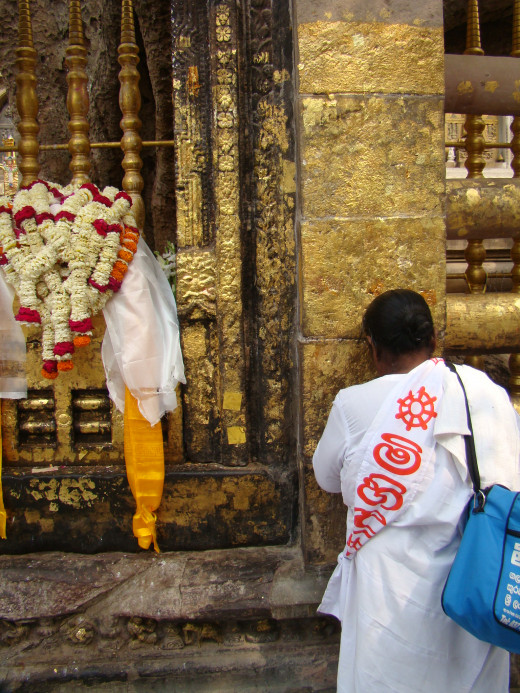
The Diamond Throne or Vajrasana
I saw a Sri Lankan pilgrim trying to get some soil from within the enclosure, but failing. It’s the way the iron enclosure has been built. You can’t get to the ground from outside. Of course, it was built with this in mind. Much of the enclosure is covered with gold leaf and pilgrims keep draping white scarves on it. The Diamond Throne has a canopy made of pure gold donated by a Sri Lankan monarch hundreds of years ago; at least this is what I overheard at the enclosure. Not surprising at all.
Buddhist Books For Sale at The Mahabodhi Society
I bought two books here – ‘The Path to Emancipation’ by the well -known monk ThichNhatHanh and ‘Health Through Balance’ about Tibetan medicine by a Tibetan monk. I chatted with the young Sri Lankan monk whosold me the books. He has been practising for 15 years. He said Buddhism is all about understanding and one can understand regardless of religion. He said that in Sri Lanka they don’t refuse any alms, so they do eat meat at times, but do not kill living creatures for food, However in Bodh Gaya he has become a complete vegetarian.
I wondered – how can devotees offer meat to monks who they know have taken vows to not kill? If we stop eating the flesh of other sentient beings, will they be killed? Anyway, to each his own.
According to the sign at the entrance, this place holds the remains of two of The Buddha’ s disciples – Sariputta and Megolamana. The Mahabodhi Society with its origins in Calcutta had fought long and hard to have the Mahabodhi Temple back in Buddhist hands and up and running again.
Audio Visual Presentation on the Life of the Buddha
This is a place near the Mahabodhi Society where you can watch an AV on The Buddha’s life. You get a cheap ticket and sit in a musty hall full of mosquitos.
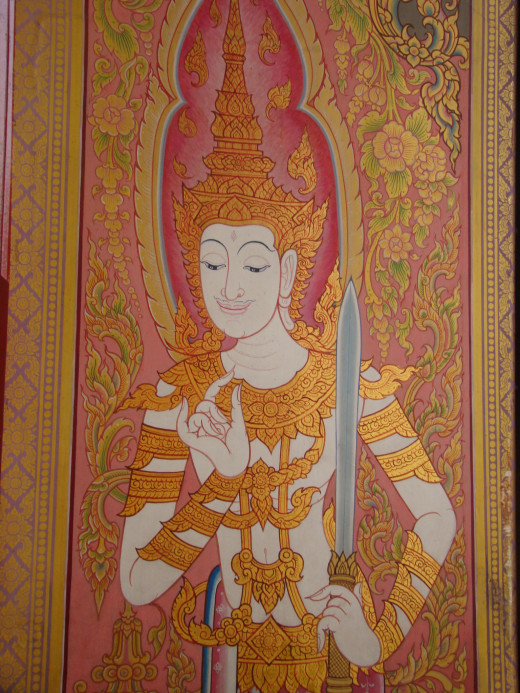
Bodh Gaya - Centre of the Buddhist World
Short History of the Mahabodhi Temple at Bodh Gaya
The region where the Mahabodhi Temple stands was long associated with the worship of Shiv and Vishnu. So when the decay of Buddhism eventually set in between the 10th and 11th centuries AD, the temple was taken over by the Saivite Mahants and became a ruin.
Sir Edwin Arnold who wrote the famous and beautiful ‘Light of Asia’ wrote that he was greatly saddened by the Mahants performing the ‘Shrad’ funeral ceremonies in the temple.
This came to the notice of the Sri Lankan monk Anagarika Dharmapala who pioneered the revival of Buddhism in India in India. When he visited the site in 1891, he was so shocked and grieved by the state of this holiest of Buddhist pilgrimages, that he vowed to restore it and formed the Mahabodhi Society to this end.
A couple of Burmese missions had already been to Bodh Gaya before him and rebuilt sections of the temple, but in the process they destroyed and concealed much, forever altering some parts. So the temple we see today is a 19th century restoration.
Even during the time of The Buddha, the Bodhi Tree was an object of pilgrimage. Emperor Ashoka was the first to build any sort of protective structure around it. His rich offerings to the shrine angered his Queen, who, it is saidm hired a magician to destroy the tree. But because of the emperor’s great sorrow, she had to have it revived.
Ashoka’s bhikkuni daughter took a branch of the tree to Sri Lanka where it still flourishes ina monastery. The scion of the present tree is said to have been brought back from this tree in Sri Lanka.
But the Bodhi Tree was destroyed again by the Sunga king Pusyamitra, reinstated again and then cut down again by the Hindu king Sasanka, but each time a sapling from Sri Lanka took its place. Then the Bodhi Tree decayed in 1876 and another of its saplings was planted by Sir Alexander Cunningham (1814-1893), the first Director General of Archaeology. So the tree we see today is about 125 years old.
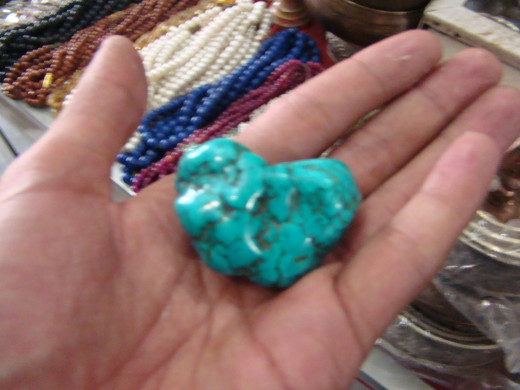
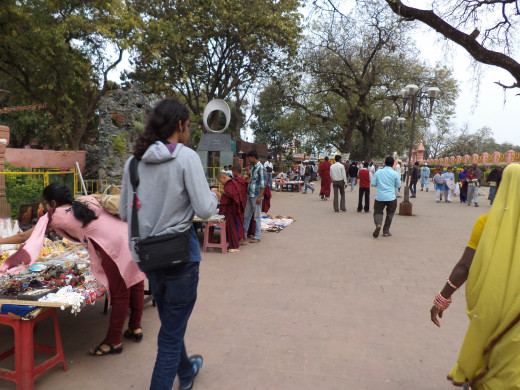
Most Important Destination for Buddhists?
Is Bodh Gaya the most important Buddhist Pilgrimage?
Souvenir Shopping Outside Mahabodhi Temple
The area outside the Mahabodhi Temple precincts is a riot of shops and colour. You get beautiful handcrafted stone ad brass items, jewellery, semi precious stones and more.
Places of Interest Near Bodh Gaya
And of course, we drove on to nearby Rajgir where The Buddha meditated on Vulture Peak, as well as Nalanda. Another interesting thing to do while here is to take a Ganges River cruise in nearby Patna and watch the sun go down on the sacred river.
Accommodation in Bodh Gaya
There are plenty of good hotels and guesthouses in Bodh Gaya. We stayed at the Heritage Hotel which had good food in its decent restaurant. Some of the monasteries take in guests for a small fee. According to Lonely Planet, Bodh Gaya has the best range of accommodation in Bihar and Jharkhand from 5-star hotels to budget hotels. .
Weather in Bodh Gaya
Bodh Gaya is a hilly area, which is why even in March it was foggy and cold in the mornings and nights. So carry warm clothes.
When to Go
The best time to visit Bodh Gaya is November to March.
Getting to Bodh Gaya from Patna
We took a cab to Bodh Gaya from Patna. It's a 3-4 hour trip. You can also take a train or a flight from Patna to Gaya from where you can cab it to Bodh Gaya.
SOURCES
Buddhist Pilgrimage by Chan Khoon San
Buddha, His Life and Teachings by Ven. Piyadassi, Thera
The Great Temple at Bodh Gaya by Prudence R. Myers in Art Bulletin Volume 40



